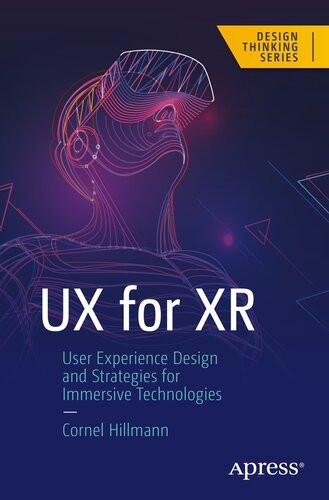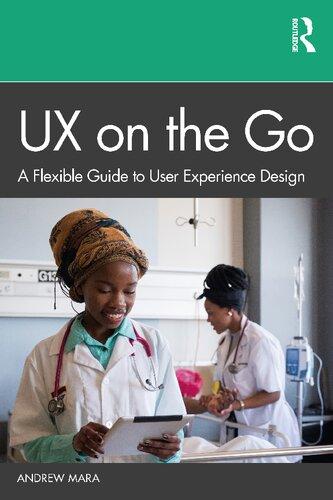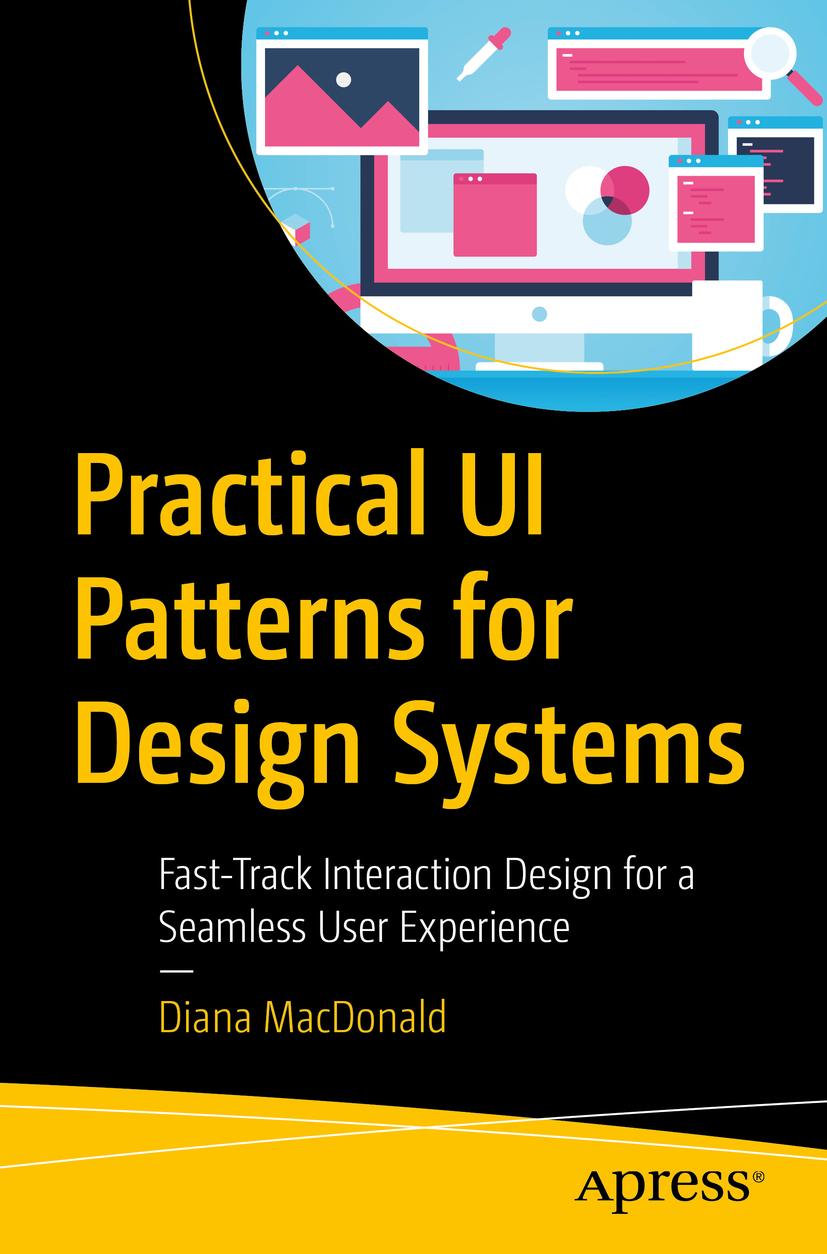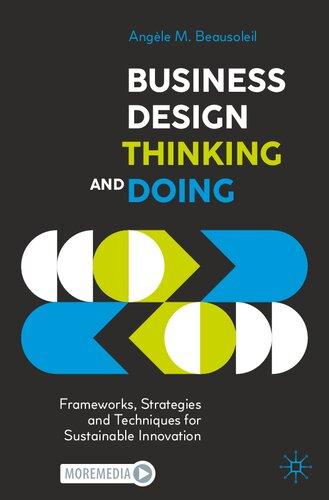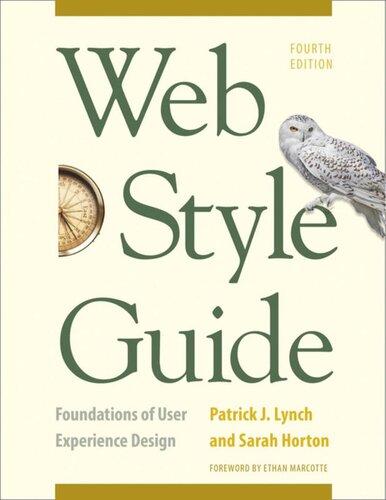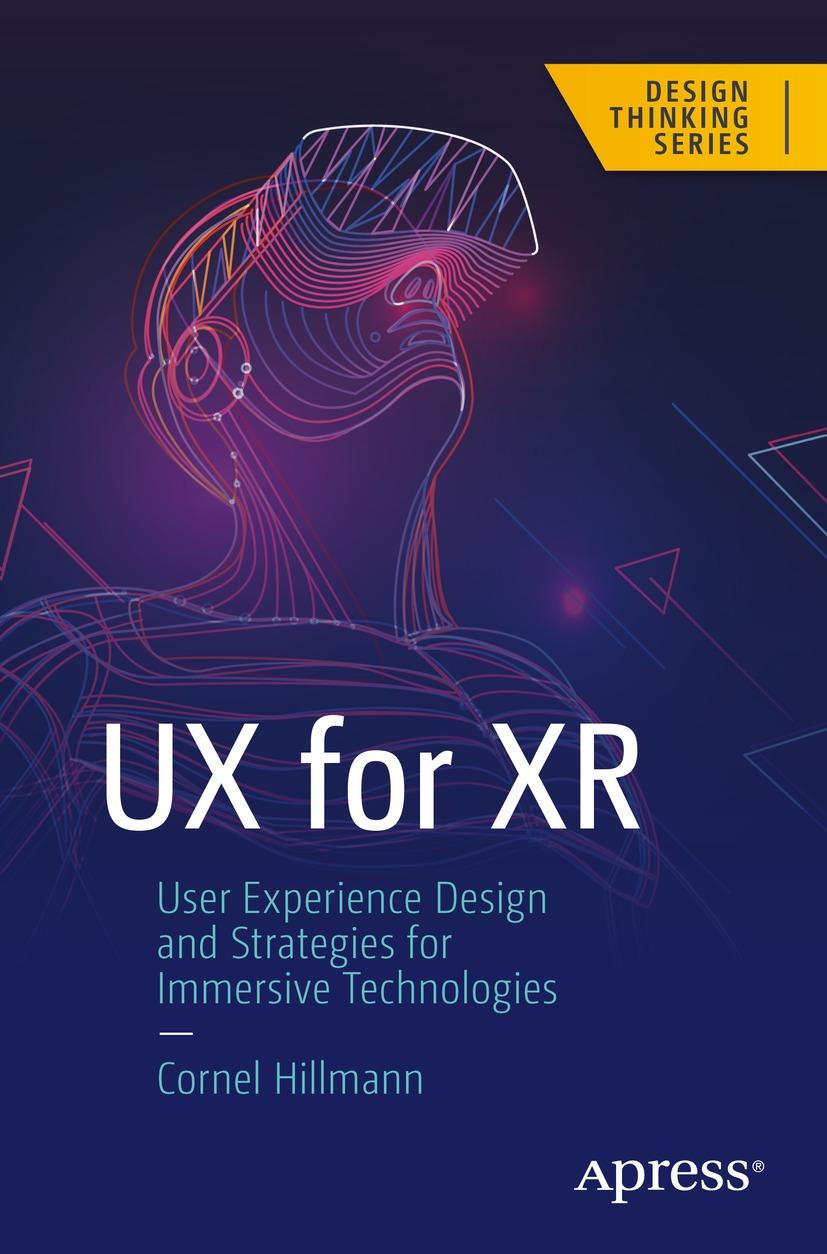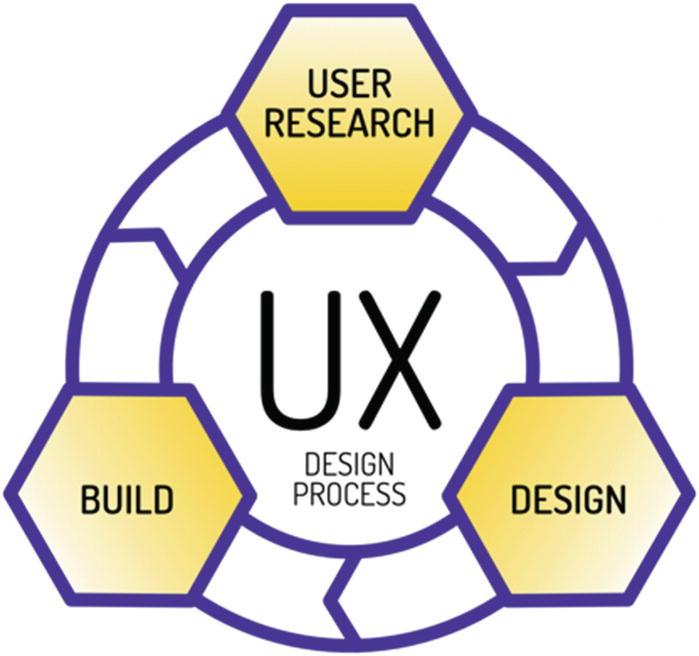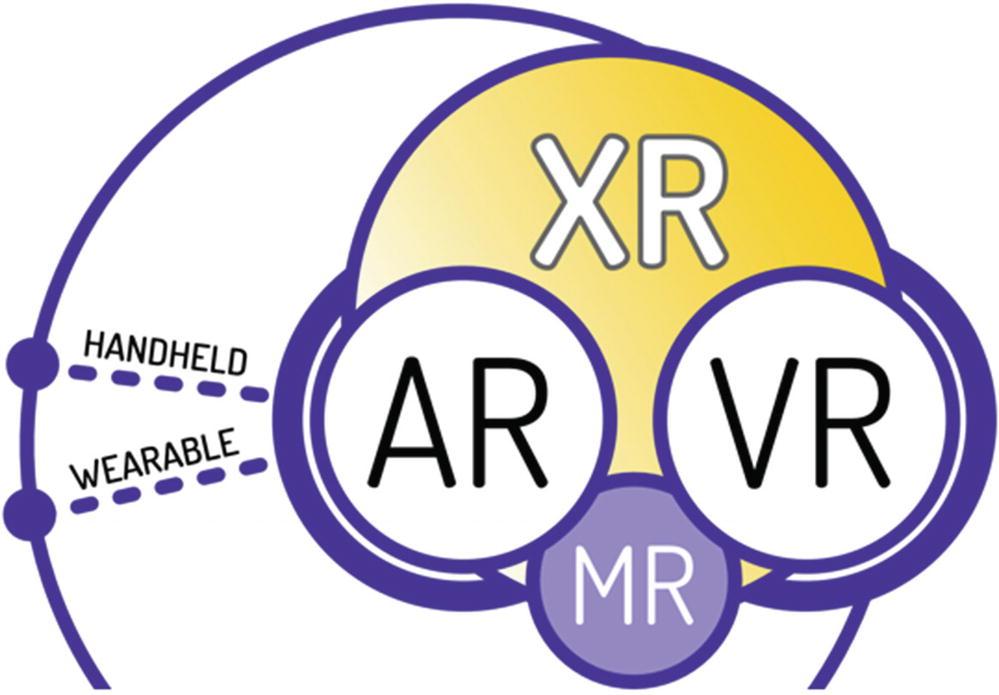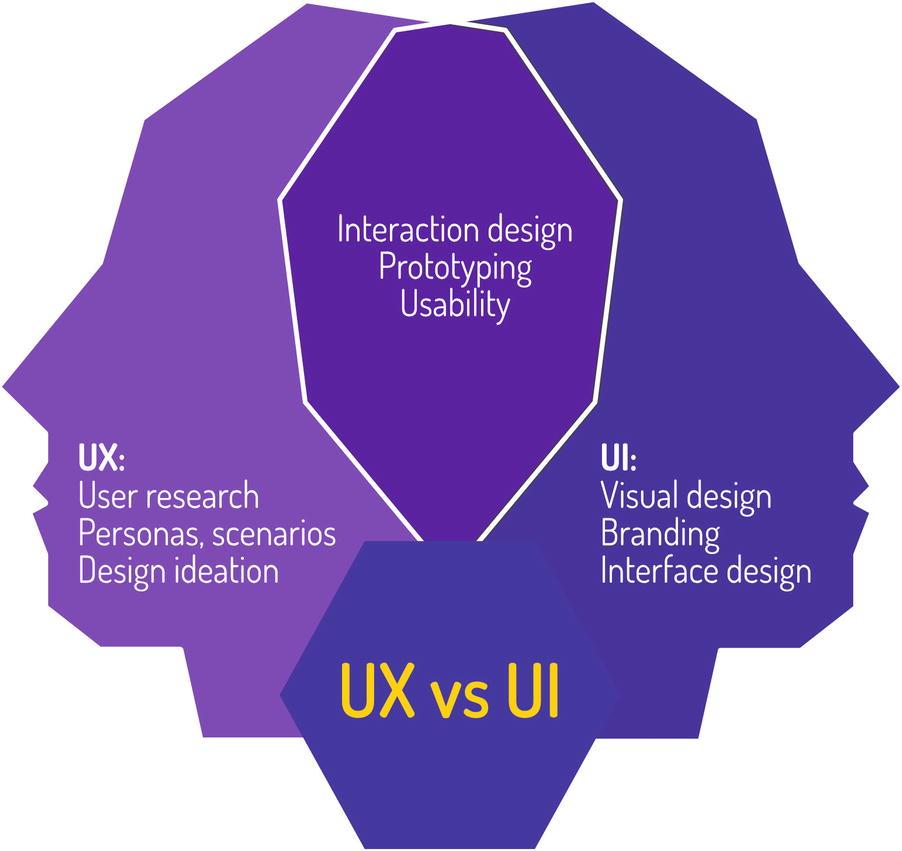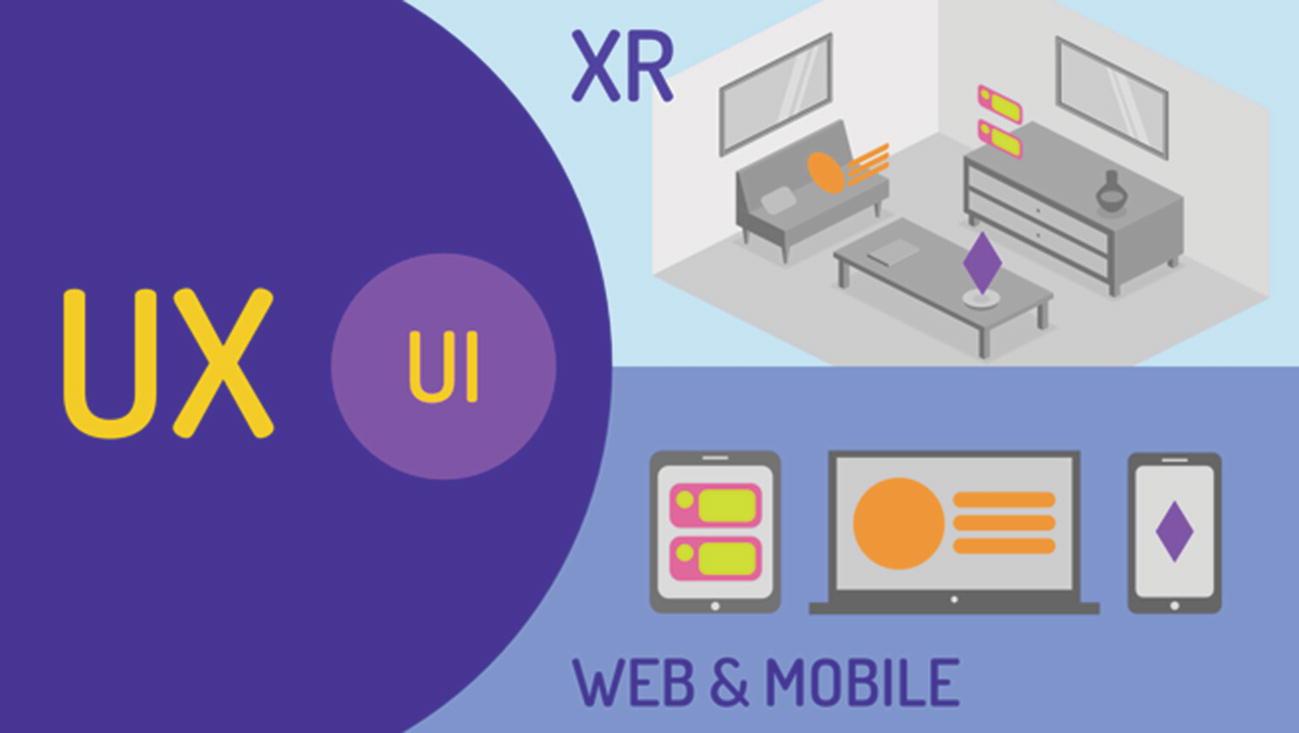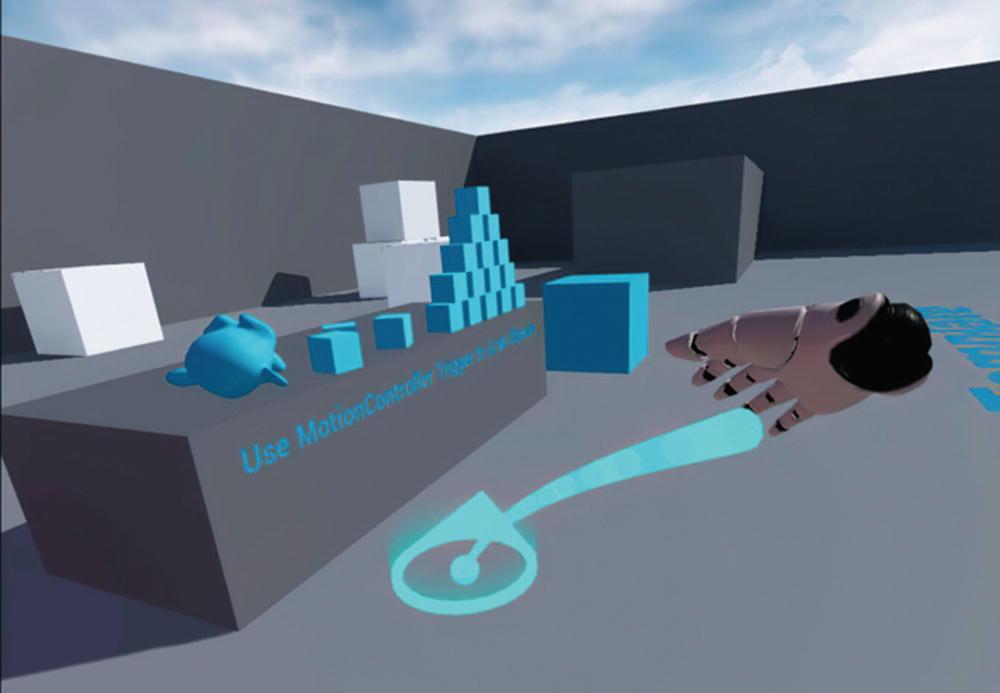UX for XR
User Experience Design and Strategies for Immersive Technologies
1st ed.
Cornel Hillmann Singapore
Any source code or other supplementary material referenced by the author in this book is available to readers on GitHub via the book’s product page, located at www.apress.com/978-1-4842-7019-6. For more detailed information, please visit http://www.apress.com/source-code.
Design Thinking
ISBN 978-1-4842-7019-6 e-ISBN 978-1-4842-7020-2 https://doi.org/10.1007/978-1-4842-7020-2
© Cornel Hillmann 2021
This work is subject to copyright. All rights are reserved by the Publisher, whether the whole or part of the material is concerned, speci�ically the rights of translation, reprinting, reuse of illustrations, recitation, broadcasting, reproduction on micro�ilms or in any other physical way, and transmission or information storage and retrieval, electronic adaptation, computer software, or by similar or dissimilar methodology now known or hereafter developed.
The use of general descriptive names, registered names, trademarks, service marks, etc. in this publication does not imply, even in the absence of a speci�ic statement, that such names are exempt from the relevant protective laws and regulations and therefore free for general use.
The publisher, the authors and the editors are safe to assume that the advice and information in this book are believed to be true and accurate at the date of publication. Neither the publisher nor the authors or the editors give a warranty, expressed or implied, with respect to the
material contained herein or for any errors or omissions that may have been made. The publisher remains neutral with regard to jurisdictional claims in published maps and institutional af�iliations.
This Apress imprint is published by the registered company APress Media, LLC part of Springer Nature.
The registered company address is: 1 New York Plaza, New York, NY 10004, U.S.A.
For Audrey, LeNoir, LeMorbier, and LeInky
Preface
This book is an exploration into the challenges and opportunities of designing for XR, an emerging space with a constantly changing landscape and almost daily breaking news of innovation. Therefore, it is an attempt to �ind a balance between landscape analysis and practical use case design evaluation. But other than pitching the dichotomy of academia vs. practice or hierarchical taxonomy vs. heuristic evaluation, the goal of this book is to capture all the elements that are driving the XR evolution forward, including history, ideas, platforms, as well as economic context and focus on the important concepts, very often lifted from toolsets or frameworks, that help designers, in their role as product designers, navigate the XR universe and give them a head start on the wider subject.
The book also re�lects my journey as an XR designer coming from interaction and game design and adapting UX methodologies to XR projects that were previously governed by game design techniques, standards, and methods, typically centered around the game design document (GDD) as the product development hub. XR product design owes the majority of its tools and techniques to game design, which has evolved over the last decades from a tiny niche to the dominating entertainment industry that it is today. A development that could be repeated with XR products, if we get the user experience right.
I was �irst introduced to virtual reality by the late Timothy Leary, out of all people. Don’t put down the book just yet. Leary was, at that point in the early to mid-1990s, way past his earlier role as the pied piper of the psychedelic generation; instead, he, in his senior years, advocated virtual reality as a vehicle for his bigger ideas. I met him at the very beginning of my career, while on my �irst real job as a designer in LA, introduced by a close friend. His enthusiastic techno utopian vision about the liberation of mankind through VR seemed wild and way over the top, to my job-focused mind at the time. Back then he wrote: “Electronic reality is more real than the physical world! This is a profound evolutionary leap. It can be compared to the jump from ocean to shoreline, when land and air suddenly become more real to the ex�ish than water!” (Timothy Leary, Chaos & Cyberculture, 1994, page 48). Even two years earlier, in 1992, at the age of 72, he explained in a press
conference of the Travel and Tourism Research Association in Minneapolis that “Virtual reality will one day make business travel all but obsolete, since people will be able to come together electronically to create…telepresence” (a quote from an article in the Baltimore Sun, from June 16, 1992).
People at that time, including my youngster self, were reacting with skepticism: “Great ideas, but it’s not going to happen in our lifetime.” Nevertheless, hanging out with such a counterculture icon taught me a lesson: Never underestimate the power of big ideas. As it turned out, he was right on a lot of his predictions that became a reality 20 years later. When I was able to get my hands on the DK1 (Development Kit 1) for the Oculus Rift in 2014, my mind was blown. Once I stepped into a life-scale 3D space that I had modeled and designed earlier and was able to move around in it using the DK1, I was more than sold. It was a life-changing moment to be able to live in your own virtual creation. The idea of being able to build your own reality echoing back conversations that took place 20 years earlier gave me more than nerd chills; it injected me with a new dose of purpose and vision.
UX design, on the other hand, was an acquired taste for me, after I �irst discovered it about a decade ago. Like an exotic fruit, it �irst tasted sweet and bitter at the same time and had to grow on me over time. Bitter, because it forced me to rethink a lot of ways in which I previously worked. Sweet, because I began to appreciate the elegance and depth of its systems and the advantages of a shared language that brings everyone together on the same page. Game design has a lot of similar components as UX design – user research, stakeholder interviews, prototyping, and focus group tests – but the UX design process is embedded into a whole canon of product design systems and philosophies that, navigating it under the general ideas of design thinking, makes it satisfying and results oriented, with the extraordinary success stories of the digital economy partly owed to it. Game design used to put less emphasis on user research and UX methods because the attitude was often “I’m not biased, I just happen to know what users want,” but that is also partially due to the fact that the game industry is often a very different animal and, to a great degree, genre driven.
The mission of this book is to map the territory, take a snapshot of where we are in the XR department of the digital transformation process, lay out approaches to XR design problems, and give hints and pointers to problem-solving ideas. The two biggest groups this book approaches are, on one hand, XR game designers interested in adopting UX design principles and, on the other hand, UX designers coming from web and mobile design, ready to take on XR. Covering the two different angles means either party will �ind some information they already know. Game designers most likely understand the role of visual scripting for frameworks, while UX designers probably don’t need an explanation of the double diamond. Nevertheless, it is important to cover both angles, because the mission of the book is to bring both of these loose ends together. The beauty of applying the UX design process to digital product design in the XR space means working with a winning formula that is proven to be successful. A special shout-out in this context is due to my technical reviewer, Tino Kuhn, whom I’ve been following for a long time, observing his inspiring career as a UX lead. Tino went well out his way to spend extra time and effort to evaluate the ideas of the book and guide the workshops that led to the practical examples, especially those covered in the last chapter. His extensive knowledge and experience as a workshopper for enterprise projects helped to keep the focus on the main goals.
The goals are to get people started in XR design, to give an overview over ideas, platforms, tools, concepts, and useful design systems and interaction patterns.
Looking back at how design patterns have evolved over this incarnation of VR, which started back in 2013 with the Oculus Rift on Kickstarter, gives an idea of how much has happened since.
During the early baby steps, when the Oculus Rift was launched in 2016, the buzzword was “presence,” and the UX focus was on what not to do: Don’t break immersion, don’t make people sick, don’t do anything unnatural if possible. Fast forward to 2021 and no one talks about “presence” anymore; instead, we keep using the term immersion in its place, because it is more useful in differentiating the context. The paranoia about immersion breaking actions and unnatural motion has been contained, because we understand it much better now and are
instead starting to embrace the opposite by often endorsing superpowers.
The intention of this book is to be a primer on the subject, including the important contextual information. XR game designers will hopefully understand how UX thinking is bene�icial to a production, while UX designers, coming from web and mobile design, will get a complete overview of where things are coming from and are headed toward and what techniques, tools, or platforms to use.
The book identi�ies prototyping as one of the main pain points for UX designers. The game engine–based process for fully functional and interactive prototypes is still a very complex and technical enterprise with a steep learning curve, or a “bag of hurt” as Steve Jobs would have said. But there is hope on the horizon, for example, the upcoming version of the XR design tool Tvori with basic interaction simulations. To be able to design in context using a spatial design app is ultimately the best long-term scenario for designers.
Finally, we should acknowledge that UX design for XR will only be mastered if one understands the secrets and wisdom of the exit burrito. What is the exit burrito? Turns out, it’s not your last meal before leaving this planet, but instead the way to end a game in the VR title Job Simulator. You have to grab a burrito from a suitcase and stuff it into your face with two bites to con�irm your intentions to exit the game. The wisdom behind it is: The weirdest interactions can become surprisingly satisfying when paired meaningfully and playtested properly. The secret to unlocking XR creativity is: The idea of literal gestures triggering meaningful action opens the door to endless opportunities. How about literally kicking a can down the road in VR to extend playtime or to literally hold a stake in a VR meeting to identify a stakeholder, when raising hands? Well, this can get pretty silly, but at the same time fun and inspirational, and that is what XR is all about. It’s playtime for the mind.
We are currently moving into a mature state of the industry, but the innovations are just getting started to hit big time. The VR-associated gaming platform Rec Room has become a unicorn, currently valued at US$ 1.25 billion, and a US Army deal has secured Microsoft a US$ 21.88 billion contract for the HoloLens. In the meantime, Snapchat, Niantic, and Apple are preparing the launch for their own AR glasses, while
designers were recently provided with a Figma UI toolset for the HoloLens MRTK (Mixed Reality Toolkit). All these are signs that things are coming together and doors are opening to an XR future full of opportunities.
The Metaverse is on its way in, alongside technologies that will change our life. In the last part of the book, the topics blockchain and NFTs (nonfungible tokens) are discussed in an XR context. A very polarizing subject, due to the rise of cryptocurrencies, speculative excess, and bubble fears. But before generalizing Bitcoin & Co and the underlying future technology, I would say: Hold…or better yet hodl… your horses. Blockchain technology will be part of our future in one way or another, apart from how hyperactive �inancial markets deal with it. It may even be devoid of greed and possibly become minerless, free, feeless, regulated, and green or even help with climate change accountability – promising initiatives to accomplish that are on the way (including blockchainforclimate.org).
If this book inspires you to take it a step further and dive deeper into VR development using the Unreal game engine, I recommend you have a look at my �irst book, Unreal for Mobile and Standalone VR (Apress, 2019). The book covers all steps to create professional VR applications from scratch, using Blueprint visual scripting and ef�icient production pipeline techniques. It also includes two complete tutorials: a VR product presentation and a VR puzzle game.
Another resource worth mentioning is my own website, where I will be updating contextual information for this book, including updates on the Reality UX Lab project mentioned in Chapters 4 and 6. Please feel free to join the discussion and share your feedback and input at studio.cgartist.com.
—Cornel Hillmann
Acknowledgments
The biggest thanks go out to my wife, Audrey, with her substantial support for my XR (extended reality) projects as a consultant, concept evaluator, tester, and critic.
An extra grateful thank you has to go to my technical reviewer, Tino, who spared no effort to deep dive into the subjects and challenges of this book project.
I also have to give my thanks to game design veteran Pascal Luban, for his in-depth discussion over UX (user experience) vs. game design and his insightful thoughts on the subject based on his long experience. My thanks go out to my cousin Wido Menhard, Executive Vice President of Digital Health at Siemens Healthineers, supporting my research of HoloLens AR applications in the medical �ield.
Special thanks to Mark Davies of Nexus Studios, Los Angeles, for his insights, time, and input as an industry professional from the perspective of a cutting-edge XR studio. A special shout-out to Sophia Prater whose innovative design system Object-Oriented UX (OOUX) might just be the missing link in XR design and UX design. A special thank you goes to the humancodable.org team, authors of the VR Advanced Framework for UE4, for discussing the role of frameworks and UX in XR. A special thanks to Singapore AR pioneers HelloHolo for letting me test the new HoloLens 2 when it �irst came out.
Thanks to the academic community in Singapore and the Unreal developer network, including the VR (virtual reality) association in Singapore and its helpful members.
And last but not least, thanks to the people who bought my previous book and inspired me to keep going with their appreciation and friendly encouragement.
Table of Contents
Chapter 1: Introduction
1.1 Welcome to the Spatial Computing Era
1.2 Mapping the Territory: UX
1.3 Mapping the Territory: XR
1.4 Merging the UX and the XR Universe
1.5 Crisis As an Accelerator
1.6 Summary
Chapter 2: The History and Future of XR
2.1 Introduction
2.2 XR: From Early Experiments to the Fourth Transformation
2.2.1 UX Before Oculus VR
2.2.2 The Timeline of UX for AR Devices
2.2.3 The Decade That De�ined XR
2.2.4 Behind the Scenes of Industry 4.0
2.2.5 UX As a Market Maker for XR Applications
2.2.6 The Elements of XR Design
2.2.7 XR: The Subculture Context
2.2.8 UX Design for Life 4.0
2.2.9 XR as a UX-Driven Marketing Paradise?
2.2.10 UX for XR in EdTech, MedTech, and Beyond
2.3 VR: A Roller-Coaster Ride into the Future
2.3.1 When UX Thinking Was Injected into VR: The Epic Story of Oculus
2.3.2 Surviving the Hype Curve
2.3.3 The Apple XR Lineup
2.3.4 VR UX: Usability First
2.3.5 Setting the Bar for VR Usability
2.3.6 The Elements of VR Usability
2.3.7 Alyx: The Gold Standard for VR Usability
2.3.8 Designing the VR Future, Beyond Usability
2.3.9 User-Centric Design in a Changing Digital Environment
2.3.10 VR Usability Heuristics
2.3.11 UX: Storyboarding, Ideation, and User Journey Maps for VR
2.3.12 Future-Proo�ing Design Methods
2.4 AR: Handheld AR Success Stories, Prototypes, and the AR Cloud
2.4.1 AR Application Types and Device Categories
2.4.2 Projection-Based AR
2.4.3 The AR Road Map
2.4.4 AR Success Stories
2.4.5 UX Design for AR Spaces
2.5 A New Era of XR Gami�ication: UX and User Engagement
2.5.1 The XR Gami�ication Layer
2.5.2 The XR Gami�ication Toolset
2.5.3 XR Onboarding with Gami�ication
2.5.4 VR and Gami�ication
2.5.5 AR Gami�ication
2.6 Summary Chapter 3: The Rise of UX and How It Drives XR User Adoption
3.1 Introduction
3.2 UX and the Macroeconomics of the Next Big Thing
3.2.1 UX Designers and the Digital Economy
3.2.2 Macrotechnology Forces
3.2.3 How Free-to-Play Games Disrupted the Gaming Industry
3.2.4 The Culture Clash: UX Design vs. Game Design
3.2.5 Conversion Events
3.2.6 From Human-Centered Design to the Human-Centered Economy
3.2.7 Economic Success as an Accelerator
3.3 Key Lessons from Three Decades of VR Experiences
3.3.1 1990s VR: The Public Is Ready, the Technology Is Not
3.3.2 The Visual Scripting Evolution: From Virtools to Blueprints and Bolt
3.3.3 VR Solutions with Staying Power
3.3.4 Emerging VR Conventions
3.3.5 The Shifting Landscape of VR
3.4 XR Design: User Agency and Storytelling
3.4.1 The Importance of Frameworks for UX Design
3.4.2 The Types of XR Projects and XR Designers
3.5 XR Fundamentals: HCI, Usability, and UX
3.5.1 VR Controllers and Usability Decisions
3.5.2 The Form Follows Function Cliché in a UX Context
3.5.3 What UX Really Means for XR
3.6 Summary
Chapter 4: UX and Experience Design: From Screen to 3D Space
4.1 Introduction
4.2 Creative Solutions for the XR Friction Funnel
4.2.1 The UI Evolution into 3D Space
4.2.2 Understanding the User in the Funnel
4.2.3 The XR World Is 3D, Just Like the Real World
4.2.4 3D Navigation as a Superpower
4.3 The Fundamentals of Designing Spatial XR Experiences
4.3.1 The UX Design Process for Digital XR Products
4.3.2 The Double Diamond in XR
4.3.3 UX Design Innovation: OOUX
4.3.4 OOUX in Action
4.3.5 Case Study: Reality UX
4.3.6 3D, Spatial Object Design and User Interaction
4.3.7 The Social AR Object As an App and How to Design It
4.4 Immersive Interaction: Senses, Haptics, Gestures, Audio, and Voice
4.4.1 XR Interaction Design and the OODA Loop
4.4.2 The GDD and XR Interaction Design
4.5 XR and Mindful Design
4.6 Summary
Chapter 5: Pioneering Platforms and UX Learnings
5.1 Introduction
5.2 Handheld AR Breakthroughs
5.2.1 Spatial Storytelling with Adobe Aero
5.2.2 3D Tools of the AR Trade
5.2.3 Social Media AR
5.2.4 The Handheld AR Landscape
5.2.5 Handheld AR UX
5.3 VR: The Oculus Ecosystem
5.3.1 Ideation, Grayboxing, and Early Prototyping
5.3.2 Frameworks and Tools
5.4 Microsoft HoloLens: Entertain, Inform, Assist, and Inspire
5.4.1 The Vision: A Mixed-Reality Mirror World with Azure Spatial Anchors and Microsoft Mesh
5.4.2 Prototyping with Microsoft Marquette
5.4.3 The Mixed Reality Toolkit (MRTK)
5.4.4 Prototyping an XR UI with Desktop UX/UI Tools
5.4.5 VR, AR, MR: The Evolution of Prototyping
5.5 VR Tours: 360 Video, VR180, and Immersive Photo Tours
5.5.1 VR Tour Content Creation and UX Considerations
5.5.2 Adding Narrative Elements to VR Tour Media
5.6 Summary
Chapter 6: Practical Approaches: UX and XR in the Real World
6.1 Introduction
6.2 Case Study: Gallery X, Part 1
6.2.1 Prototyping Utopia
6.2.2 VR Gallery X: The Initial Design Brief
6.2.3 VR Gallery X: Discovery
6.2.4 VR Gallery X: Exploration
6.2.5 Persona, User Journey, and User Story
6.2.6 Object-Oriented UX in an XR Context
6.3 Case Study: Gallery X, Part 2, Thinking, Designing, Building, Testing
6.3.1 The Verbal Storyboard
6.3.2 The Visual Storyboard and Low-Fidelity Prototype
6.3.3 Building the High-Fidelity Prototype and Testing It
6.3.4 The Double Diamond Process and Its Results
6.4 UX Strategy, Analytics, Data Acquisition, and UX Audits for XR Projects
6.4.1 Mozilla XR Resources
6.4.2 User Feedback Based on WebVR
6.4.3 UX Audits for XR Projects
6.5 Summary
6.6 Conclusion: The Future Is Here
6.6.1 The Next Growth Story: UX for XR
6.6.2 The XR Future: A Balance of Opportunities and Risk Mitigation
6.6.3 XR Futurism: Designing Reality
Glossary
Resources
Index
About the Author
Cornel Hillmann is a CG artist and XR designer with over 20 years of experience in the media and entertainment, advertising, and design industry. He’s worked with brands including Panasonic, Jaguar, The Future Is Wild, the Singapore International Film Festival, Razor, and many others. Cornel started his career as an art director in Los Angeles after receiving his diploma in computer graphics. He founded CNT Media GmbH in Hamburg, Germany, and Emerging Entertainment Pte. Ltd. in Southeast Asia, before establishing studio.cgartist.com as a design studio in Singapore. Cornel has lectured master classes for immersive media postproduction and advanced 3D, VR, and media design courses at Limkokwing University and is the author of Unreal for Mobile and Standalone VR (Apress, 2019). Cornel spends most of his time using the Unreal engine for XR productions and enterprise visualizations.

During his spare time, you will �ind him in the VR multiplayer classic Dead and Buried II and occasionally in Population: One, Hyper Dash, and Altspace, unless jamming in his virtual synth studio, working on his personal passion projects, or writing software and creative tech reviews for his network partners.
About the Technical Reviewer
Tino Kuhn
is a UX design lead and digital creative director, known to effortlessly combine creative storytelling and modern-day experience design with UX strategy and creative direction of digital marketing in different media and industry verticals. He has won several awards in creative advertising and digital marketing for his innovative ways in implementing impactful product experience on mobile platforms. His work includes UX design and strategy for such clients as Emirates, Vodafone, and Nando’s, with a recent focus on education marketing and EdTech for innovative social platforms.
Tino established a new media design studio in his hometown Hamburg before moving to Melbourne, Australia, where he has continued his career as an early adopter of emerging technologies in the creative marketing space. He is currently working with Open Universities Australia, one of the biggest education and academic provider platforms in Australia. His passion for 360 video and VR gaming motivates him to develop a future gami�ied learning platform and a mental health app as a side gig.
© Cornel Hillmann 2021
C. Hillmann, UX for XR, Design Thinking
https://doi org/10 1007/978-1-4842-7020-2 1
1. Introduction
Cornel Hillmann1
(1)
Singapore, Singapore
The extended reality (XR) era is here, and its rise will have an increasing visibility in the decade ahead of us. The 2020s is the beginning of a wider adoption of the next computing platform after years of experimentation and innovation.
The intention of this book is to give an overview of the opportunities in extended reality application for UX designers, as well as to evaluate the approaches and techniques of user experience (UX) design targeting virtual reality (VR) and augmented reality (AR) applications for XR developers and producers.
The reasons for that are obvious: UX design is a success story. The rise of UX design in the last decade is re�lected in the overwhelming success of the mobile economy, which was to a large degree driven by the re�ining of UX standards, techniques, and tools for maximum ef�iciency and impact (Figure 1-1).
Figure 1-1 The UX design process (image by C Hillmann)
UX design is now a well-oiled machine when it comes to web and mobile app development. It has been proven to work; it has been shown to create success stories and wealth in the digital economy. Over the last 10 years, we have seen the rise of a whole UX universe with conventions, industry bodies, training courses, literature, and a healthy demand in the job market. Even though the role of UX is constantly being re�ined and debated, it is here to stay, because it ful�ills its promise to optimize the user experience, which in turn means to create successful digital products and to ensure user retention rates.
AR and VR applications, as part of an emerging XR industry, have had a mixed record when it comes to user retention numbers. Due to the constantly changing landscape of formats, technological breakthroughs, and software and hardware platforms, it has been dif�icult to establish a winning formula to attract a critical mass of satis�ied users, with a number of notable exceptions.
Facing this situation, which as a whole is very typical for an emerging technology, makes it obvious that XR application development needs UX design and strategy more than ever. It is crucial for the success of an emerging industry to monitor user behavior and re�ine its key components based on that data.
The UX design approach that has worked so well for web and mobile applications is, to a great degree, transferable to XR application development, when it comes to its guiding principles. Nevertheless, when it comes to the practical application in the production process, it is faced with a number of obstacles due to technical and format hurdles.
The idea of this book is to identify what has been learned so far, regarding UX design for XR applications, and what areas still need to be re�ined in terms of UX standards while evaluating possible solutions for the inevitable pain points.
In this way, this book aims to help analyze UX practices for XR environments and review the techniques and tools for prototyping and designing XR user interactions. The objective is to approach the design for experiential state and spatial cognition, using established UX KPIs, while taking into account the social dynamics, emotional framework, and wider industry context.
1.1 Welcome to the Spatial Computing Era
Coined as “the next big thing” by Apple CEO Tim Cook on January 21, 2020, augmented reality will “pervade our entire lives” over the next 5–10 years. Virtual reality is already building momentum with the success of the Oculus Quest by Facebook, while AR devices such as the Magic Leap and Microsoft’s HoloLens are building their technical and usability frameworks and community. The rise of XR technology is rede�ining how humans interact with digital content, and new possibilities are bringing a major shift in UX strategies and design to revolutionize human-computer interaction (HCI). While user experience design has risen to the center stage of organizations to build meaningful and relevant experiences for their users on digital devices with �lat screens, a new era of spatial interaction is transforming the design space and its techniques around storytelling, interaction design, strategy, research, and information architecture.
Extending traditional digital platforms to the new frontier of XR requires taking into account what best practices, new concepts, and conventions have been established and what learnings can be brought forward from case studies involving industry leaders. Looking at practical examples from the �ield of handheld AR (HAR) breakthroughs,
VR success stories, and experimental interaction concepts of pioneering XR platforms allows us to map out a framework of UX guidelines, thus closing in on opportunities and challenges that lie ahead. Even though the XR landscape is constantly changing, it holds a set of promises to the user that are long term and are unlikely to change as the technology matures (Figure 1-2).
Figure 1-2 Extended reality (XR) (image by C. Hillmann)
The perspective of UX for XR is to focus on the user bene�its, analyze what works best by having empathy for the user, and articulate solutions for design problems. While this mission is clear, it is very often the technical complexity and the novel prospects of the XR medium that carry an additional weight in the scope of work for UX XR design work. What it comes down to is the fact that a UX designer targeting XR applications does not have to be a coder, but does have to understand how the technology works and what implications design decisions have, when it comes to technical dependencies. Once the groundwork is done, a wide space of opportunities opens up. It is very often the excitement of pioneering design work that builds momentum in emerging technologies. The passion of UX designers inspired by the new opportunities in XR is fueling innovation, and these designers, by
taking user agency, are making sure that these ideas work for the intended audience.
1.2 Mapping the Territory: UX
The general concept of user experience design has been around for centuries, and, in hindsight, it seems logical that it culminated in a �lourishing design industry that is shaping the digital economy today.
But, while UX design for electronic devices and digital applications has been around since the 1990s, it only took center stage in the last decade. The overwhelming success of the iPhone and the rise of the digital economy centered around mobile devices, plus the need to unify the design for web and mobile applications for consistency, made UX design an unparalleled success story. Taking a user-centric design approach, applying research, and testing routines turned out to be the right approach for the digital economy. It was the driver behind most of the ecommerce shooting stars and the secret sauce that helped disruptive unicorns to capture the platform economy era.
But let’s not forget that the remarkable rise of UX design is a fairly recent phenomenon. Before 2009, the UX designer job description was practically unknown in the job market. Although it existed in the context of HCI research and usability testing facilities with a few larger organizations, it was, in the end, Apple that radically committed to the UX concept as a core process for developing new products. As a result, it turned the company into the most valuable public company in the world, dominating every industry it took on. As design legend Don Norman, who joined Apple in the early 1990s, pointed out: UX entails all aspects of the user’s interaction with the company, its services, and its products.
This very holistic design approach is today very often overshadowed by the typical work of UX designers. Not out of ignorance, but out of practical considerations. Most designers in the UX �ield working on apps and websites have no control over the devices their design solution is used on. Their work is focused on the digital product and its user interaction alone, while the device UX is of course handled by the hardware developer.
This situation has created the misleading conception that UX design is actually UI design for the most part. Job descriptions very often underline this notion by advertising for UX/UI designers. Once again, not by ignorance, but out of practical considerations. A lot of UX design for mobile and web applications is centered around UI interaction. Typical examples are ecommerce and booking apps, where the user �low is directly mirrored in the interaction with the UI. As a matter of fact, it is a very common misconception that UX design means the design side of front-end development only. But that may only be a distorted perception, because it just happened to be where most of the work was.
With the transition into the XR era, this is going to gradually change, and UX design will actually �ind its way back to its holistic roots of considering all aspects of the interaction between a design and its user, due to the fact that this interaction will entail a lot more than just a UI (Figure 1-3).
Figure 1-3 UX vs. UI design (image by C. Hillmann)
Spatial interaction, gestures, and speech are just a few of the new elements that will de�ine the new paradigm. As a matter of fact, the X in UX, the experience factor, will weigh in on a new level and will re�ine what experience actually means in an XR context.
The term experience has been somewhat overused in the early wave of VR enthusiasm, when every company wanted one. Designing a VR experience instead of a VR app sounded more exciting and entailed a lot more promises of capturing the user’s attention with immersive technologies.
Nevertheless, the frenzy of the early VR hype is way behind us, and the term experience is still a good and descriptive term for an XR app, as it expresses a user-centric interaction that entails more than a few �inger swipes on a screen. It addresses multiple senses and has the potential to completely simulate the real world and the many ways a human interacts with it.
For UX designers, this is a whole new playing �ield with endless opportunities, but also a huge amount of problems to solve (Figure 14).
Figure 1-4 UX and UI design for spatial computing vs. mobile and web (image by C. Hillmann)
Think about it. For the longest time, one of the biggest headaches for UX/UI designers pushing out prototypes in the mobile and web space has been responsive designs: making user interaction consistent across various screen formats and sizes and resolutions, using �luid grids, anchors, responsive breakpoints, and device templates. Tools such as Sketch, Adobe XD, and Figma, to name a few, have been helpful in prototyping designs that were very close to the actual �inal product on various devices.
The problem of responsive design could potentially be a much tougher nut to crack in the XR space, if you are aiming to have consistency between AR handheld devices, such as tablets and AR wearables as AR glasses, based on the same content. Both device categories interact with the same spatial environment, but the user interacts with the content in dramatically different ways. Tapping a spatial AR object on a tablet could �ill the majority of the screen space with a contextual UI, but wearing AR glasses viewing the same space in stereoscopic 3D would have a devastating effect, if an activated UI �loats close to the user’s eyes, blocking their �ield of view (FoV).
UX designers for web and mobile apps had to deal mostly with �lat rectangles of different sizes and orientations, horizontal and vertical. Wearable AR with an endless screen and a spatial component adds a design challenge to UX conventions.
UX design for web and mobile applications has so far lived in framed rectangles: the horizontal rectangle for the standard monitor and the vertical rectangle for the mobile phone, plus the mix of both for the rest of mobile devices, including tablets, as experienced through responsive design. The limitation of a �lat rectangular design space is a convenience for designers. It allows the focus on a framed �lat surface without spatial dependencies. The rectangular screen space is the successor of the book page without the responsive and interactive elements and can therefore draw from thousands of years of history of designing and organizing a rectangular surface space to appeal to a user who is already very familiar with it.
The XR space completely breaks away from this tradition and consistency. On one side, it is more at home in the realms of simulation technology, but on the other side also closer to the immersive worlds of theater, magic, and storytelling. But the arch that really connects both
the non-XR and the XR user experience design is the high-concept approach of solving design problems by learning about the user’s needs, building prototypes, and testing them until they work as intended.
1.3 Mapping the Territory: XR
UX design is very often associated with marketing and CX (the customer experience) as an umbrella category, with strong links to advertising, graphic design, and Apple computers. Sketch, the UX application of choice for designers for the longest time before Figma took over, is only available on Apple devices, and, very often, typical UX designers have a background in graphic, screen, or UI design.
The XR world is inherently a bit of a different animal here. Its home is originally the world of 3D and game engines (and is therefore more Windows oriented). The fact that most XR applications are produced with game engines, like Unity or Unreal, brings them also closer to the game development community. Some XR applications have been games, but even in the case of an EdTech or enterprise XR project, the resources, talent, pipeline, and production technique would be based on game development standards (Figure 1-5).
Figure 1-5 VR prototyping using an Unreal engine template
Games have used and still use UX as part of the design process that is very often focused on UI interaction. UX design and game design have to some degree merged happily with the rise of mobile games in the last decade, but the focus of UX in game design remains on the UI, up to today (UX game design jobs are most often advertised as UX/UI positions, indicating a UI focus).
A legitimate question would be: How were games designed without UX design techniques based on user �lows and storytelling?
The answer is that game design has always covered to a great degree what UX design does, when it comes to the more holistic tasks beyond UI interaction. User �lows and storytelling are traditionally part of the game design document (GDD) that is the very foundation of every game production. The GDD describes in detail what the user is expected to do at any point in the game, how the game mechanics play out, and what components are part of the production. Part of that is also prototyping, usability testing, and game testing, including focus group tests.
Considering these facts, one would wonder, why would an XR production based on game development standards need UX at all?
The answer to that question is that game development standards are good for games, but for anything else, non-game XR apps, such as enterprise, B2B, MedTech, EdTech, and so forth, basic game design approaches fall short of understanding the user’s needs. Games are really a special case in XR development, where the designer often knows their audience really well. Game designers usually know their audience better than UX designers, due to the nature of the game industry and its distinct genres and iterative game mechanics. UX designers, for web and mobile apps, very often have no idea about their users. That's why a strong focus is on acquiring knowledge about the user, creating personas and user journeys. UX design has also had a much stronger focus on conversion as part of the complete user journey, due to its closer ties to ecommerce, marketing, and advertising —think of booking apps, for example. Game designers, on the other hand, know their genre audience better and have a heads-up on what game mechanics are popular with the user base and what pitfalls to avoid. Plus, gamers are very vocal, proactive, visible, and thus easier to
